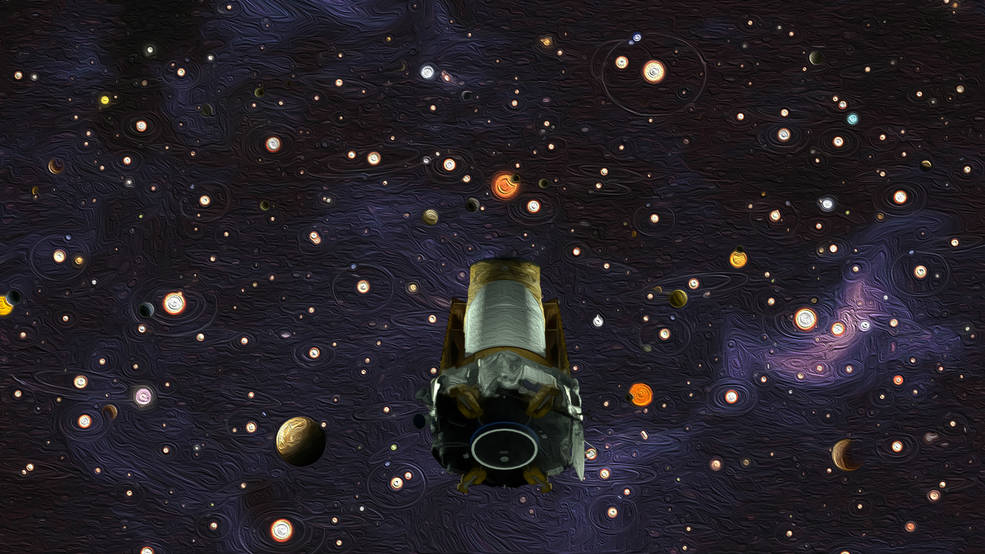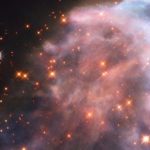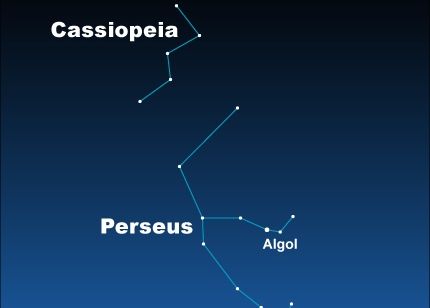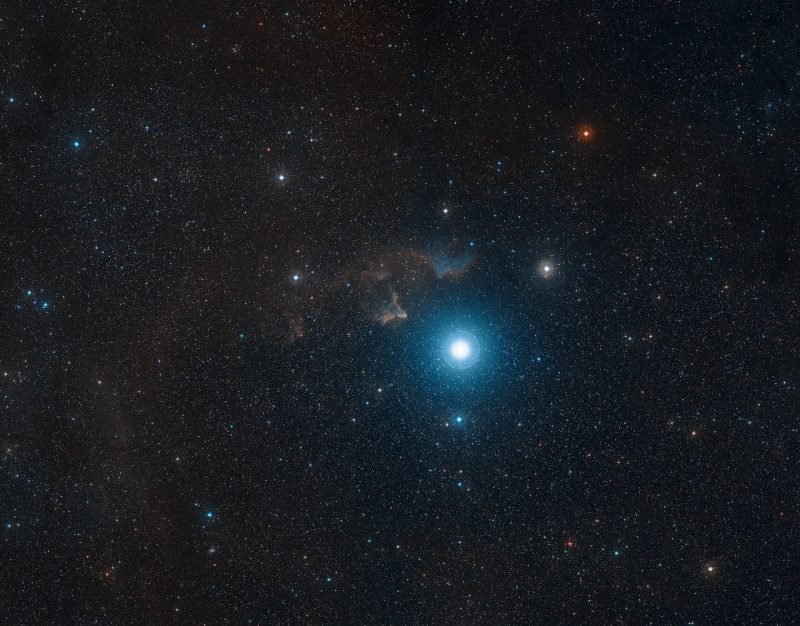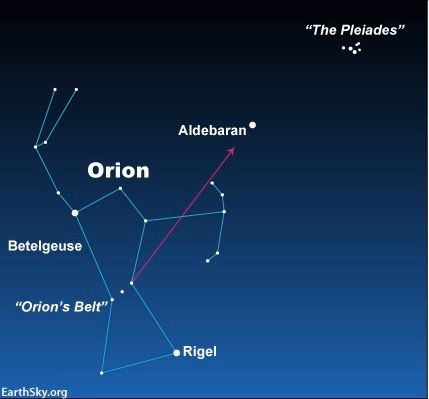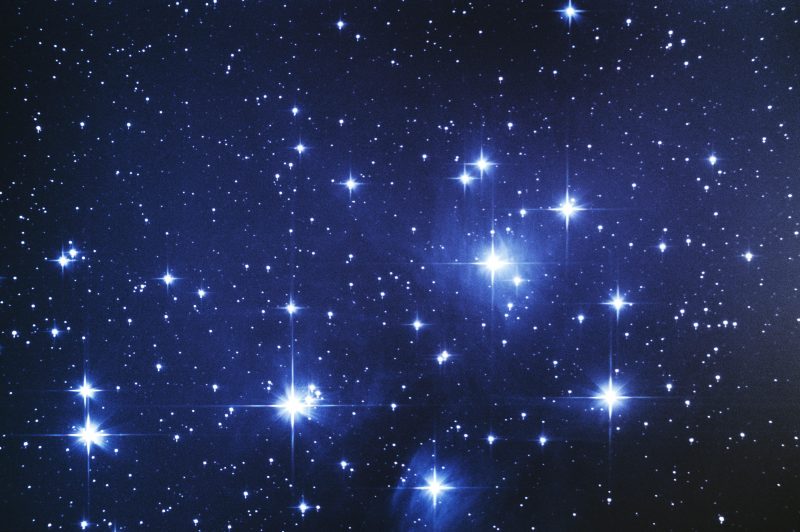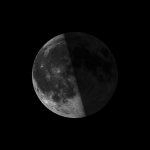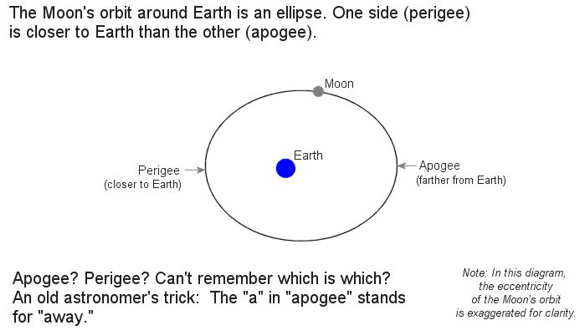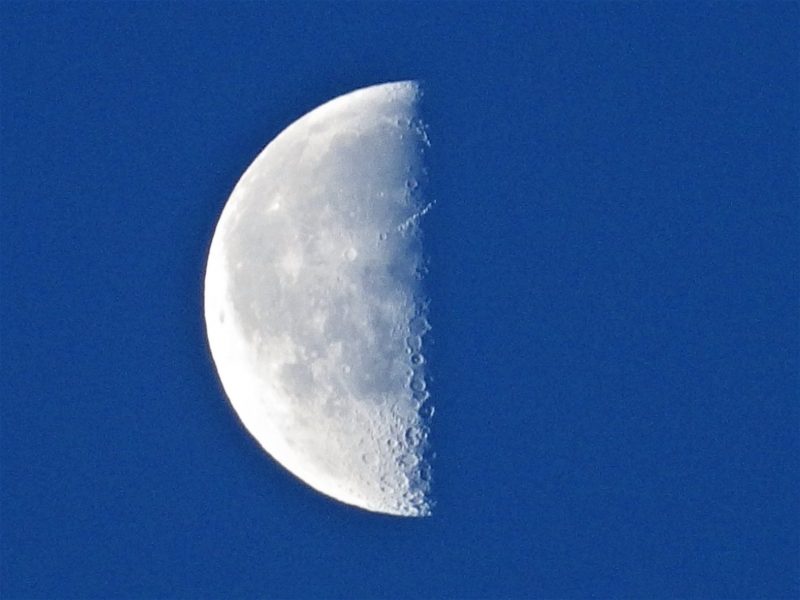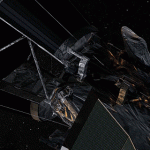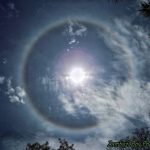
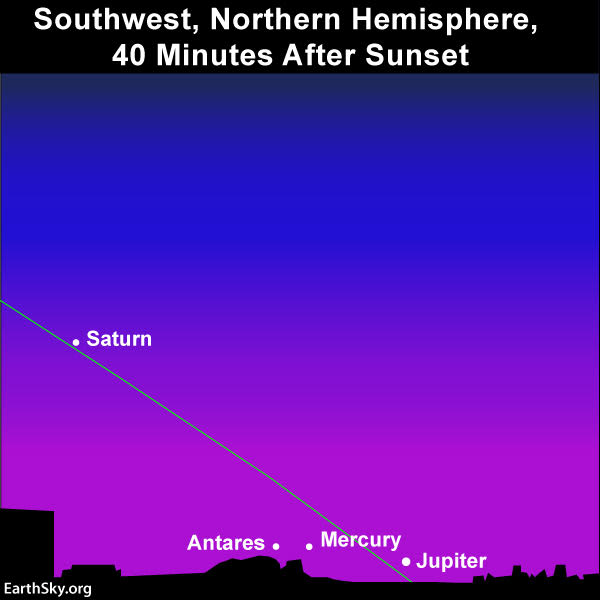
At nightfall, from northerly latitudes, Mars is easy to catch in the southern sky (outside the sky chart), while fainter Saturn is moderately easy to spot in the southeast sky. From northerly latitudes, like those in the U.S. and Europe, it’ll be difficult to glimpse the planets Mercury and Jupiter (plus the star Antares) in the glow of evening dusk.
Mars is by far the easiest planet to catch in the evening sky in November, 2018. Saturn, though not as bright as Mars, is also a fine evening object, shining as brilliantly as as 1st-magnitude star. Nominally, Mercury and Jupiter are evening planets for most of the month, until their departure from the evening sky in late November. From northerly latitudes, however, these two worlds follow the sun beneath the horizon shortly after sundown, making Mercury and Jupiter hard to view in the glare of evening dusk. Venus, the brightest planet, puts on a good show in the November morning sky, shining at its brilliant best as the morning “star” as the month draws to a close. Click the name of a planet to learn more about its visibility in November 2018: Venus, Jupiter, Saturn, Mars and Mercury

After a night of watching Taurid meteors, you just might be able to catch the moon and Venus before daybreak on November 4, 5 and 6. Read more.
Venus is the brightest planet, beaming mightily in the east before sunrise. Each day throughout November 2018, this blazing beauty of a planet will rise sooner before sunrise and will brighten all the while. Although Venus will be a fixture of the morning sky until mid-August 2019, it’ll shine at its brightest best as the morning “star” in late November and early December 2018.
Look for the waning crescent moon in the vicinity of Venus before sunrise November 4, 5 and 6, as depicted on the above chart. Venus recently entered the morning sky on October 26, 2018, so in early November, Venus will still be rather low in the eastern sky just before sunrise. Find an unobstructed eastern horizon, and, if you have binoculars, bring them along. Venus will be higher up and easier to view in the morning sky as the month progresses.
At mid-northern latitudes, Venus rises roughly one hour before sunrise by around November 4. By the month’s end, Venus will rise some 3 hours before the sun.
At temperate latitudes in the Southern Hemisphere, Venus rises about one hour before the sunup on or near November 6. By late November, Venus will rise two hours before the sun.
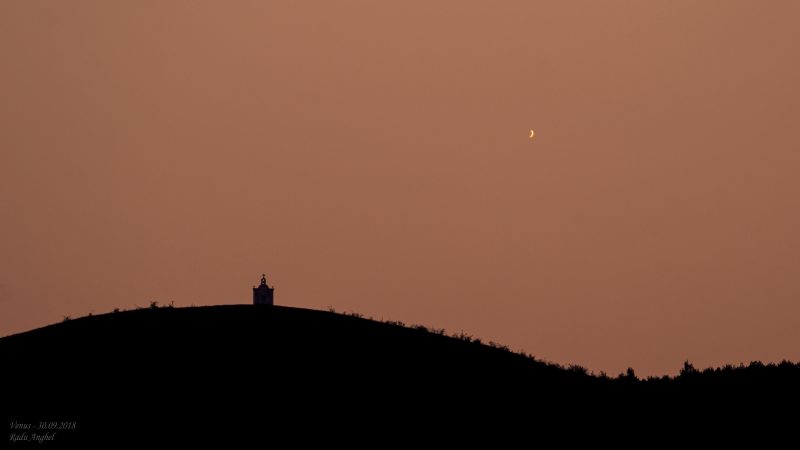
View larger. | No, it’s not the moon. It’s Venus – September 30, 2018 – visible through a small telescope in a crescent phase. Venus is up only shortly after sunset now. It’ll pass between us and the sun on October 26. Photo by Radu Anghel in Bacau, Romania. Thank you, Radu!
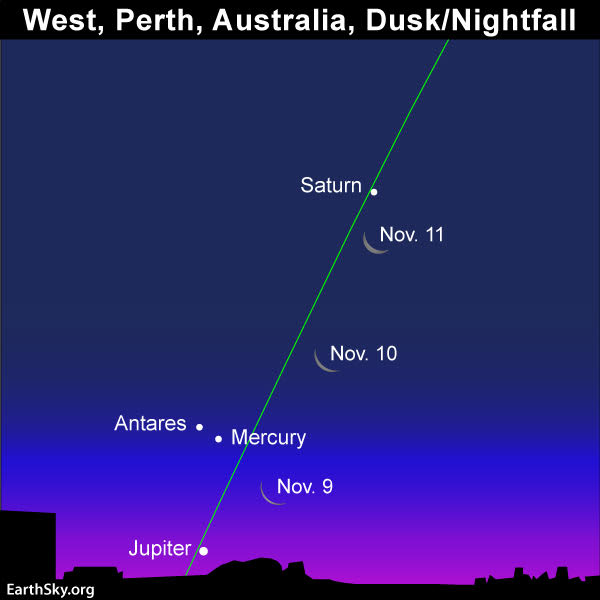
Live in the Southern Hemisphere? Given an unobstructed horizon in the direction of sunset, you have a good chance of catching the young waxing crescent moon near the planets Mercury and Jupiter on or near November 9, 2018. Read more.
Jupiter will disappear from the evening sky sometime this month. Day by day, Jupiter falls closer to the setting sun, and sets sooner after sundown. By late November 2018, Jupiter will have passed over into the morning sky.
Jupiter stays out longer after sunset in the Southern Hemisphere. That’s because the ecliptic (pathway of the sun, moon and planets) hits the evening horizon at a steeper angle than at comparable latitudes in the Northern Hemisphere.
For instance, at mid-northern latitudes (United States, mainland Europe, Japan), Jupiter sets about one hour after the sun in early November and then sets with the sun near the month’s end.
In contrast, at temperate latitudes in the Southern Hemisphere (Cape Town, South Africa, and southern Australia), Jupiter sets about 1 1/2 hours after the sun in early November and with the sun near the month’s end.
If you live in the Southern Hemisphere or northern tropics, let the slender waxing crescent moon guide your eye to Jupiter (and Mercury) for several evenings, centered on or around November 9 (see the sky chart above).
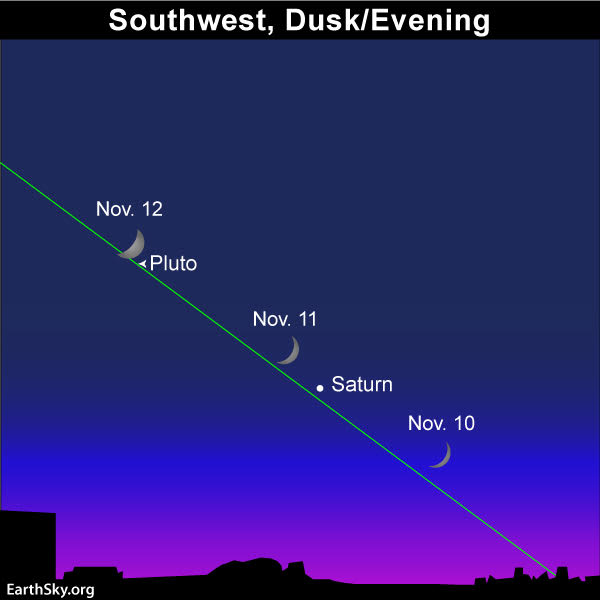
The moon will set at early evening, providing dark skies for the North Taurid meteor shower. Read more.
Use Mars to find Saturn in November 2018. Although Mars fades somewhat this month, the red planet remains bright and beautiful, shining more brilliantly than a 1st-magnitude star throughout November 2018. In November, Mars transits – reaches its highest point in the sky – around dusk/nightfall in the Northern Hemisphere, and around sunset in the Southern Hemisphere. Once you see Mars, look for Saturn way below Mars and quite low in the southwest sky.
Click here for a recommended sky almanac providing you with the transit times for Mars.
From mid-northern latitudes, Saturn stays out until around 8 p.m. (9 p.m. daylight saving time) in early November. By the month’s end, Saturn will set around 6 p.m. Mars pretty much sets around midnight all month long.
From temperate latitudes in the Southern Hemisphere, Saturn sets around 10 to 11 p.m. in early November and around 9 p.m. in late November. Mars stays out until after midnight throughout the month.
You can tell Mars from Saturn because Mars has a reddish color and Saturn looks golden. Binoculars show their colors better than the eye alone.
Watch for the moon to pair up with Saturn on or near November 11 (see sky chart above) and with Mars on or near November 15 (see sky chart below).

Look for the moon in the vicinity of Mars on November 14, 15 and 16. Read more.
Both Mars and Saturn are slowly dimming throughout the month. Because Mars is dimming at a faster rate than Saturn is, Mars appears nearly 3 times brighter than Saturn at the beginning of the month, yet only somewhat more than 1 1/2 times brighter by the month’s end.
Remember Mars’ historically close opposition of August 28, 2003? That year, it was closer and brighter than it had been in some 60,000 years. The July 2018 opposition was the best since 2003.
Click here for more about close and far Mars oppositions
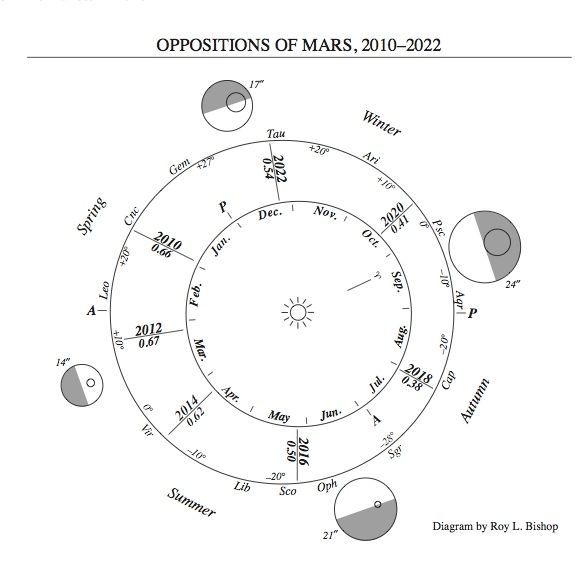
Diagram by Roy L. Bishop. Copyright Royal Astronomical Society of Canada. Used with permission. Visit the RASC estore to purchase the Observer’s Handbook, a necessary tool for all skywatchers. Read more about this image.
Mercury, the innermost planet of the solar system, is an evening planet (at least nominally) for most of the month in November 2018. Mercury’s greatest elongation falls on November 6, 2018, but the Southern Hemisphere has the big advantage over the Northern Hemisphere for spotting Mercury. Even so, try your luck at catching the young moon with Mercury after sunset around November 8, 9 and 10, as shown on the sky chart below.

At northerly latitudes, like those in the US and Europe, it’ll be quite the challenge to spot the young moon, plus the planet Mercury in the glow of evening dusk. Read more.
What do we mean by bright planet? By bright planet, we mean any solar system planet that is easily visible without an optical aid and that has been watched by our ancestors since time immemorial. In their outward order from the sun, the five bright planets are Mercury, Venus, Mars, Jupiter and Saturn. These planets actually do appear bright in our sky. They are typically as bright as – or brighter than – the brightest stars. Plus, these relatively nearby worlds tend to shine with a steadier light than the distant, twinkling stars. You can spot them, and come to know them as faithful friends, if you try.
Bottom line: In November 2018, two planets shine in the evening sky all month long: Mars and Saturn. Venus lights up eastern sky before sunrise. Mercury and Jupiter for the most part are lost in the glare of evening dusk, but might be possible to see early in the month, low in evening twilight. Click here for recommended almanacs; they can help you know when the planets rise, transit and set in your sky.
Don’t miss anything. Subscribe to EarthSky News by email
Help EarthSky keep going! Donate now.
from EarthSky https://ift.tt/1YD00CF


At nightfall, from northerly latitudes, Mars is easy to catch in the southern sky (outside the sky chart), while fainter Saturn is moderately easy to spot in the southeast sky. From northerly latitudes, like those in the U.S. and Europe, it’ll be difficult to glimpse the planets Mercury and Jupiter (plus the star Antares) in the glow of evening dusk.
Mars is by far the easiest planet to catch in the evening sky in November, 2018. Saturn, though not as bright as Mars, is also a fine evening object, shining as brilliantly as as 1st-magnitude star. Nominally, Mercury and Jupiter are evening planets for most of the month, until their departure from the evening sky in late November. From northerly latitudes, however, these two worlds follow the sun beneath the horizon shortly after sundown, making Mercury and Jupiter hard to view in the glare of evening dusk. Venus, the brightest planet, puts on a good show in the November morning sky, shining at its brilliant best as the morning “star” as the month draws to a close. Click the name of a planet to learn more about its visibility in November 2018: Venus, Jupiter, Saturn, Mars and Mercury

After a night of watching Taurid meteors, you just might be able to catch the moon and Venus before daybreak on November 4, 5 and 6. Read more.
Venus is the brightest planet, beaming mightily in the east before sunrise. Each day throughout November 2018, this blazing beauty of a planet will rise sooner before sunrise and will brighten all the while. Although Venus will be a fixture of the morning sky until mid-August 2019, it’ll shine at its brightest best as the morning “star” in late November and early December 2018.
Look for the waning crescent moon in the vicinity of Venus before sunrise November 4, 5 and 6, as depicted on the above chart. Venus recently entered the morning sky on October 26, 2018, so in early November, Venus will still be rather low in the eastern sky just before sunrise. Find an unobstructed eastern horizon, and, if you have binoculars, bring them along. Venus will be higher up and easier to view in the morning sky as the month progresses.
At mid-northern latitudes, Venus rises roughly one hour before sunrise by around November 4. By the month’s end, Venus will rise some 3 hours before the sun.
At temperate latitudes in the Southern Hemisphere, Venus rises about one hour before the sunup on or near November 6. By late November, Venus will rise two hours before the sun.

View larger. | No, it’s not the moon. It’s Venus – September 30, 2018 – visible through a small telescope in a crescent phase. Venus is up only shortly after sunset now. It’ll pass between us and the sun on October 26. Photo by Radu Anghel in Bacau, Romania. Thank you, Radu!

Live in the Southern Hemisphere? Given an unobstructed horizon in the direction of sunset, you have a good chance of catching the young waxing crescent moon near the planets Mercury and Jupiter on or near November 9, 2018. Read more.
Jupiter will disappear from the evening sky sometime this month. Day by day, Jupiter falls closer to the setting sun, and sets sooner after sundown. By late November 2018, Jupiter will have passed over into the morning sky.
Jupiter stays out longer after sunset in the Southern Hemisphere. That’s because the ecliptic (pathway of the sun, moon and planets) hits the evening horizon at a steeper angle than at comparable latitudes in the Northern Hemisphere.
For instance, at mid-northern latitudes (United States, mainland Europe, Japan), Jupiter sets about one hour after the sun in early November and then sets with the sun near the month’s end.
In contrast, at temperate latitudes in the Southern Hemisphere (Cape Town, South Africa, and southern Australia), Jupiter sets about 1 1/2 hours after the sun in early November and with the sun near the month’s end.
If you live in the Southern Hemisphere or northern tropics, let the slender waxing crescent moon guide your eye to Jupiter (and Mercury) for several evenings, centered on or around November 9 (see the sky chart above).

The moon will set at early evening, providing dark skies for the North Taurid meteor shower. Read more.
Use Mars to find Saturn in November 2018. Although Mars fades somewhat this month, the red planet remains bright and beautiful, shining more brilliantly than a 1st-magnitude star throughout November 2018. In November, Mars transits – reaches its highest point in the sky – around dusk/nightfall in the Northern Hemisphere, and around sunset in the Southern Hemisphere. Once you see Mars, look for Saturn way below Mars and quite low in the southwest sky.
Click here for a recommended sky almanac providing you with the transit times for Mars.
From mid-northern latitudes, Saturn stays out until around 8 p.m. (9 p.m. daylight saving time) in early November. By the month’s end, Saturn will set around 6 p.m. Mars pretty much sets around midnight all month long.
From temperate latitudes in the Southern Hemisphere, Saturn sets around 10 to 11 p.m. in early November and around 9 p.m. in late November. Mars stays out until after midnight throughout the month.
You can tell Mars from Saturn because Mars has a reddish color and Saturn looks golden. Binoculars show their colors better than the eye alone.
Watch for the moon to pair up with Saturn on or near November 11 (see sky chart above) and with Mars on or near November 15 (see sky chart below).

Look for the moon in the vicinity of Mars on November 14, 15 and 16. Read more.
Both Mars and Saturn are slowly dimming throughout the month. Because Mars is dimming at a faster rate than Saturn is, Mars appears nearly 3 times brighter than Saturn at the beginning of the month, yet only somewhat more than 1 1/2 times brighter by the month’s end.
Remember Mars’ historically close opposition of August 28, 2003? That year, it was closer and brighter than it had been in some 60,000 years. The July 2018 opposition was the best since 2003.
Click here for more about close and far Mars oppositions

Diagram by Roy L. Bishop. Copyright Royal Astronomical Society of Canada. Used with permission. Visit the RASC estore to purchase the Observer’s Handbook, a necessary tool for all skywatchers. Read more about this image.
Mercury, the innermost planet of the solar system, is an evening planet (at least nominally) for most of the month in November 2018. Mercury’s greatest elongation falls on November 6, 2018, but the Southern Hemisphere has the big advantage over the Northern Hemisphere for spotting Mercury. Even so, try your luck at catching the young moon with Mercury after sunset around November 8, 9 and 10, as shown on the sky chart below.

At northerly latitudes, like those in the US and Europe, it’ll be quite the challenge to spot the young moon, plus the planet Mercury in the glow of evening dusk. Read more.
What do we mean by bright planet? By bright planet, we mean any solar system planet that is easily visible without an optical aid and that has been watched by our ancestors since time immemorial. In their outward order from the sun, the five bright planets are Mercury, Venus, Mars, Jupiter and Saturn. These planets actually do appear bright in our sky. They are typically as bright as – or brighter than – the brightest stars. Plus, these relatively nearby worlds tend to shine with a steadier light than the distant, twinkling stars. You can spot them, and come to know them as faithful friends, if you try.
Bottom line: In November 2018, two planets shine in the evening sky all month long: Mars and Saturn. Venus lights up eastern sky before sunrise. Mercury and Jupiter for the most part are lost in the glare of evening dusk, but might be possible to see early in the month, low in evening twilight. Click here for recommended almanacs; they can help you know when the planets rise, transit and set in your sky.
Don’t miss anything. Subscribe to EarthSky News by email
Help EarthSky keep going! Donate now.
from EarthSky https://ift.tt/1YD00CF


